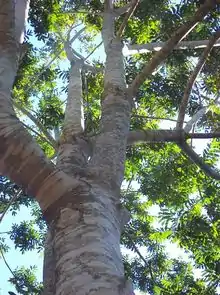| Dysoxylum rufum | |
|---|---|
 | |
| Scientific classification | |
| Kingdom: | Plantae |
| Clade: | Tracheophytes |
| Clade: | Angiosperms |
| Clade: | Eudicots |
| Clade: | Rosids |
| Order: | Sapindales |
| Family: | Meliaceae |
| Genus: | Dysoxylum |
| Species: | D. rufum |
| Binomial name | |
| Dysoxylum rufum | |
| Synonyms[2][3][4][5] | |
Dysoxylum rufum is a rainforest tree in the family Meliaceae, found in eastern Australia. It occurs on a variety of different soils and rainforest types. From as far south as Bulahdelah, New South Wales to the McIlwraith Range in far north eastern Australia.[4][5] The specific epithet rufum refers to the rusty red of the leaf, fruit and flower hairs of this species.
Common names
Dysoxylum rufum is known variously by the common names Australian mahogany, bastard pencil cedar, false rosewood, hairy rosewood, rusty mahogany, red bean, red heart, and rusty bean.[5]
Description
Usually a small to medium-sized tree.[3] Though it reaches 40 metres tall with a stem diameter of 90 cm at Murray Scrub.
Leaves
Leaflets are nearly opposite on the stem, without serrations. Asymmetrical at the leaf base. Leaflets 5 to 17 cm long. Lanceolate to broad lanceolate in shape with a fine point at the leaf tip. Unusually, the leaflets are a dull green above the leaf, and a brighter green below. Hairy under the leaf. Leaflet stalks 2 to 3 mm long, but much longer for the terminal leaflet, where it is up to 25 mm long. The compound leaf contains around 19 leaflets. With a stalk 4 to 10 cm long.
Flowers, fruit and regeneration
Pleasantly scented white flowers form on panicles from December to February. The panicles form from the leaf axils. And when mature, the flower scent becomes less pleasant. The flower calyx is hairy.
The fruit is a round yellowish capsule, around 2 cm in diameter, mostly five-valved. Also covered with hairs which can irritate the skin. Seeds inside the capsule are cream, irregular in shape, and about 5 mm in diameter. Fruit ripens from April to December. Regeneration from fresh seed is relatively swift and reliable, taking as little as three weeks. After eight weeks, germination should be complete with good results.
Timber
Onion scented wood. Mostly white with a red heartwood core which resembles the related Red Bean. Timber is vulnerable to attack from the lyctus borer.

References
- ↑ "Dysoxylum rufum". International Plant Names Index (IPNI) (2021). Royal Botanic Gardens, Kew. Retrieved 28 May 2021.
- ↑ "Hartighsea rufa". Australian Plant Census (APC). Australian Government. Retrieved 28 May 2021.
- 1 2 Taylor, J.; Harden, G. J. (1991). "Dysoxylum rufum – New South Wales Flora Online". PlantNET - The Plant Information Network System. 2.0. Sydney, Australia: The Royal Botanic Gardens and Domain Trust. Retrieved 13 Mar 2013.
- 1 2 Floyd, A. G. (2008). Rainforest Trees of Mainland South-eastern Australia (2nd, Revised ed.). Lismore, New South Wales: Terania Rainforest Publishing. p. 220. ISBN 978-0-958943-67-3. Retrieved 2010-06-28.
- 1 2 3 "Dysoxylum rufum". Australian Tropical Rainforest Plants (RFK8). Centre for Australian National Biodiversity Research (CANBR), Australian Government. Retrieved 21 April 2021.